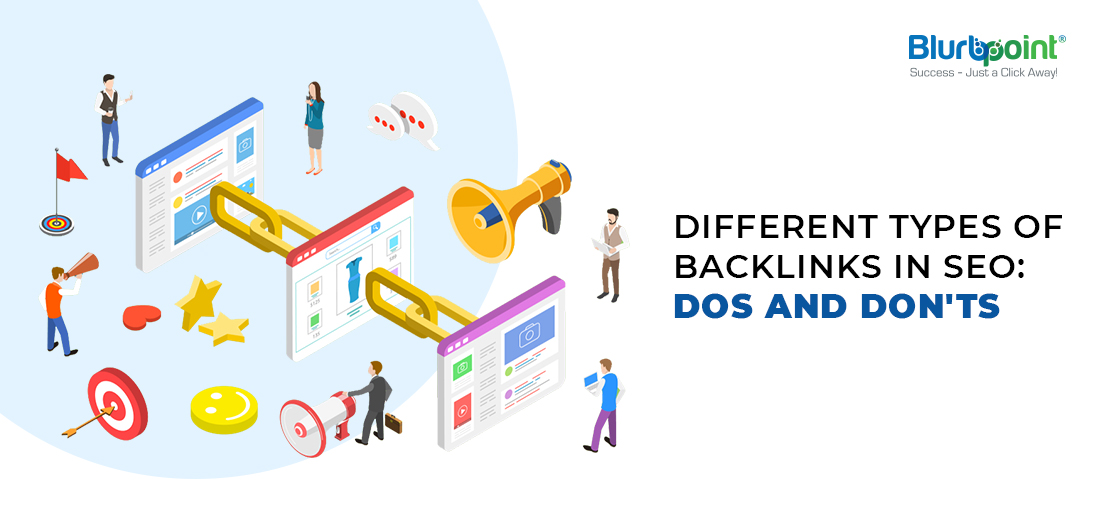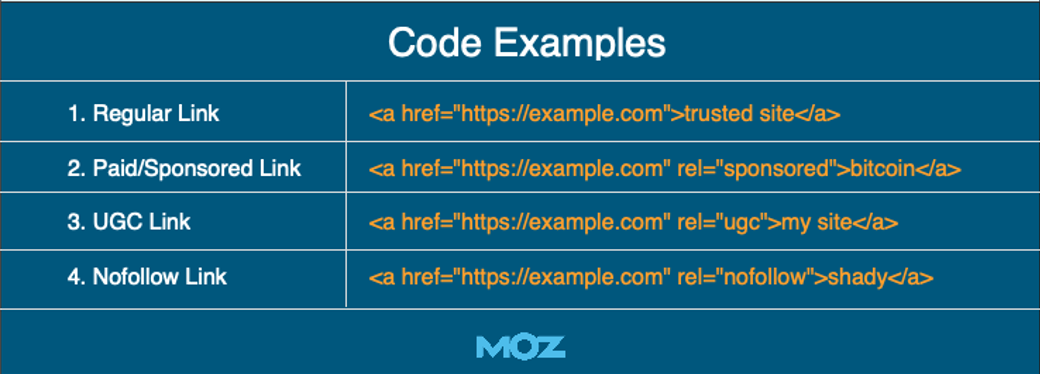GET A FREE CONSULTATION



Posted by Vishal Parmar
November 17, 2021
For an effective SEO plan, acquiring backlinks becomes prudent. Backlinks help Google understand that the site is trustworthy and recognized, so it is worth showing it in the top spot of SERPs. However, what is crucial to understand is that the Google algorithm has changed tremendously.
So, as a marketer, it’s necessary to stay in tune with what the Google algorithm wants us to do. And, Google today is not looking at the number of backlinks you add, rather the types of backlinks.
To help you understand how link building is done, this post will talk about the different types of backlinks that will help you get results. These are the backlinks you need and should pay attention to.
Please note that since there are different types of backlinks, not all types of backlinks will be created equal. This is why you need to carefully choose a link to add to your website or blog post. So, without further ado, let’s find out what those high-quality backlinks are.
Backlinks are links that appear on someone else’s website, and when clicked, the link sends the reader to your website. These are also known as one-way links, incoming links, or inbound links.
Google values backlinks because it increases your site’s authority, meaning it considers the link to be valuable. As a result, a web page with higher backlinks usually has better chances to have better organic search engine rankings.
Let’s simplify the explanation. Let’s say a blogger tags your website as a backlink on one of their blogs; if they are doing it, it means that they think your website is valuable and should be visited. Google will see the link’s popularity and also the relevance of the page. Google has something called E-A-T score- expertise, authoritativeness, and trustworthiness.
If many websites encourage readers to click on the link of your website, Google will notice it. That’s why a website needs to have high authority sites add their website or any web page as their backlinks. This can be done through content marketing campaigns. But do remember that backlinks should be placed by authoritative sites that will help you enhance your site’s presence in SERPs.
Backlinks are essential for SEO because they tell Google that the link available in another source finds it valuable, which is beneficial for the reader. When multiple sources start using your website’s backlink, it signals Google that the website is worth checking and possesses valuable content, which in return helps your website rank better.
Take backlinks to work as votes. When multiple people click on your backlink, Google takes it as an upvote and considers your site to be seen in the top search results.
Moreover, backlinks have been used for a long time. Google’s algorithm has changed multiple times, but one thing that remains the same is backlinks. Furthermore, Google considers backlinks to be an essential key factor in deciding a website’s ranking.
Search engines, such as Google value do follow links and are the ones that are useful for SEO. do follow links are organic, which is why Google acknowledges them. And, to cut it short, these backlinks tell Google that the website didn’t buy them. Instead, they are accurate and relevant to the content written.
Indirectly do-follow links inform Google and other search engines that the content is high quality and valuable to the readers. The source code of a do-follow link will be straightforward. Also, it doesn’t require rel attributes, unlike the others.
When it comes to nofollow, these are less valuable backlink types and less common. When such links are used, they tell the search engines that they are better to be ignored. One should ignore these links because they tell webmasters that these links are not to be followed.
The source code for nofollow will look like a dofollow link, but the main difference between the two will be the use of the tag called rel=nofollow.
Even if someone uses a nofollow link, there has to be a good mixture of dofollow and nofollow links because that’s what Google suggests. However, do remember that Google considers do follow links to be more valuable.
UGC link (Rel=ugc), otherwise known as the user-generated link, is a new link attribute. It tells Google that the link used is an indication that it is generated by users. The introduction of this link is a lifesaver for webmasters.
UGC links allow webmasters to tell Google that the specific link is not added by them but by other people in the comment section or a forum post.
Sponsored link, rel=sponsored, is a new link attribute that Google released not a long time back. These are paid links, which, yet again, Google doesn’t want you to use a lot. This type of link is for advertisements, places as a form of sponsorship, and when someone has paid for it to be used.
These links don’t have any editorial endorsement when it comes to a webmaster’s perspective; however, with this link, Google finds out that it is untrustworthy.

Natural backlinks are valued by Google and SERPs the most. One acquires these backlinks because of the high-quality content. In addition, these are white-hat and completely free.
SEO says that natural backlinks are widely accepted, and are the safest. If you have acquired natural backlinks, your website is safe from Google penalties. Moreover, natural links will save you money from doing backlink outreach campaigns and your time.
If Google finds natural backlinks in high-quality content, rest assured, your website has better chances of ranking in SERP. Moreover, the natural link used in the content has to be relevant. Therefore, the more high-quality content that adds natural backlinks to your web page, the better.
You receive brand mentions because readers will see your brand name mentioned in the high-quality content, and it also works as a helpful tool to increase your brand awareness.
Many websites use paid backlinks to increase their site’s ranking in SERP. Although it helps your website and web pages to gain recognition since someone else will be adding your website’s name to their website, you will be paying those sites for backlinks; that’s why they are called paid backlinks.
Paid links were a great way to improve the visibility of a website and improve the domain authority, but soon after the introduction of black hat SEO, paid backlinks began to be considered a way to manipulate the search engines since they are not organic but intentional.
Another reason paid backlinks are risky is that you never know where the backlink is added to and whether the content is relevant to the backlink used. A paid backlink increases your brand awareness, but does Google consider the backlink to be valuable?
The answer is Google gives less credit to paid backlinks. Common examples of paid backlinks are affiliate links on sponsored posts.
Outreach backlinks can be both paid and natural, depending on what the other websites want. It’s a practice to reach out to websites with high domain authority, asking them to add your website as a backlink.
The way it is done is that the other website will see whether adding your website as a backlink in their content will value their off-site SEO or not.
HARO is an excellent tool to use for outreach backlinks. It connects the website with multiple media sources, which will be beneficial for you. In addition, it saves time and effort. Apart from HARO, other methods of outreach backlink prospects are broken links, resource page links, and listicle posts.
Guest posts, even though in use for a long time, can be highly beneficial for backlinks. The only thing that you need to keep in mind is the guest blog is relevant to the backlink used. Therefore, the content has to be relevant and of high quality.
Google has invested a lot of time in guest posting websites to find whether they are abusing backlinks. They have checked how valuable a piece of content is and whether the added backlink does any justice to the content written. Hence, contact an authoritative and relevant website and try to establish a good relationship with them.
Editorial backlinks, although it is a common type of backlink, are one of the best. Editorial backlinks help your website to gain recognition in the right way. You will find editorial backlinks only in sites that are recognized and offer quality content.
Whether the backlink is earned or natural, doesn’t matter because the editorial content will be relevant to the content shared.
Moreover, the article’s author will consider adding a backlink only when they are sure that the link will help their readers. They are added based on the content written, so they are considered natural and organic.
Do note that editorial backlinks are what Google is looking for. Anyone reading editorial content will value the backlink of your website and web pages as well.
If you know a few bloggers who write content relevant to your industry or your website, you can reach out to them to add backlinks. And when you do that, that’s called blogger outreach backlinks. But the crux is reaching out to bloggers who share content that is relevant to your industry.
Considering that you reach out to these bloggers when they place your backlink, it will create an opportunity for your website to be seen by more people because when readers find backlinks in a blog, they do click on that.
Free tool backlinks are a way to entice a reader to check what the website is about. In addition, free tool backlinks allow websites to help their readers because they highlight that there is something that they can try for free.
The free tool doesn’t have to be the full version of the tool, just the basic version. But ensure that the free tool backlink used in the content is relevant. Yet again, relevancy plays an important role. Call to action is also an excellent way to add free tool backlinks. This will prompt readers to try it.
Infographics are created to teach readers or help them readers understand a particular topic. Infographics are beneficial for the readers because they use both texts and images. So, when the infographic gets linked with a backlink, it becomes an infographic backlink.
Whenever someone shares the same infographic, whether on a guest blog, social media channels, or website, your website gets credited as the infographic’s creator.
Businesses apart from their company website create multiple online profiles. Probably a Facebook page, Instagram profile, LinkedIn profile, and so on. What one can do is link their website to these profiles, and that’s called a business profile backlink.
The links can be on industry-specific directories, social media networks, and business listings. Create different profiles on different platforms and find a place where you can add a backlink.
Social profile backlinks play an important role when it comes to ranking factors. Moreover, social media is here to stay and not going anywhere. All the social media profiles you have are important because they increase your visibility and help you grow.
The core purpose of having social profiles is to share more information about who you are, what you do, how you can help, and what you have accomplished, but all these things will go in vain if no one checks your website. That’s why you should add social profile backlinks to your profile, the blogs you have shared, and anywhere relevant.
Q&A sites help people to find information on different subjects. For example, Quora is a fantastic Q&A site where one can add a backlink to an answer that will benefit the reader. Moreover, it diversifies your link profile as well.
Although Q&A backlinks are nofollow links, they shouldn’t be ignored. Q&A backlinks drive traffic to your website, establish trust and credibility, and improve SEO.
When you are new in the industry, have launched something new, have an important announcement to make, or are newsworthy, nothing can be better than press releases.
When you contact a relevant PR agency that spreads the news that resonates with your industry, the audience reading the PR is encouraged to check your website.
PR works in multiple ways; it helps build your credibility, and improves your visibility, and a backlink added in a press release is a sure-shot way to drive more traffic to your website.
Testimonials are valuable to customers. Through testimonials, a customer finds out more information about the product they are interested in and becomes confident to go for it. The best way to acquire a testimonial backlink is to contact companies that offer them a testimonial, and in return, they will add a backlink that will take them to your website.
Testimonial backlinks can also be added to case study websites. Since testimonials play an important role in decision-making, this shouldn’t be overlooked.
Irreverent backlinks can hurt your website a lot. Relevancy is essential when adding a backlink. Any link added to a website content that has nothing to do with your website will be noticed by Google.
For example, if a digital marketing website is gaining links from a blog about board games, Google will soon find that something is amiss. A topic written on board games has nothing to do with a digital marketing website.
Hence, stay away from links from irrelevant sites, such as
Spam backlinks are not just useless, but they can affect your search engine ranking and pull you down. Spam backlinks are also called unnatural backlinks, toxic backlinks, and bad backlinks. This can make Google think that your website is probably not worth it.
Not just this, spam backlinks can also lead to the Google Penguin penalty. These links will be used in spam or low-quality websites.
Keep your website clean from spam backlinks such as:
A manipulative backlink is a term used by SEO. They are used to manipulate the ranking of a website. If Google finds out that a website’s ranking has been manipulated in an unnatural manner, such as buying links or creating links, it will hurt its reputation.
According to Google’s Webmaster Guidelines, these types of backlinks to your website hurt your SEO.
Be careful about all the backlinks that link to your website. You can’t ignore the importance of backlinks, but that doesn’t mean every backlink will work. Of course, number matters, but approach an excellent link-building strategy that will help your website and let you grow positively without being penalized by Google.
